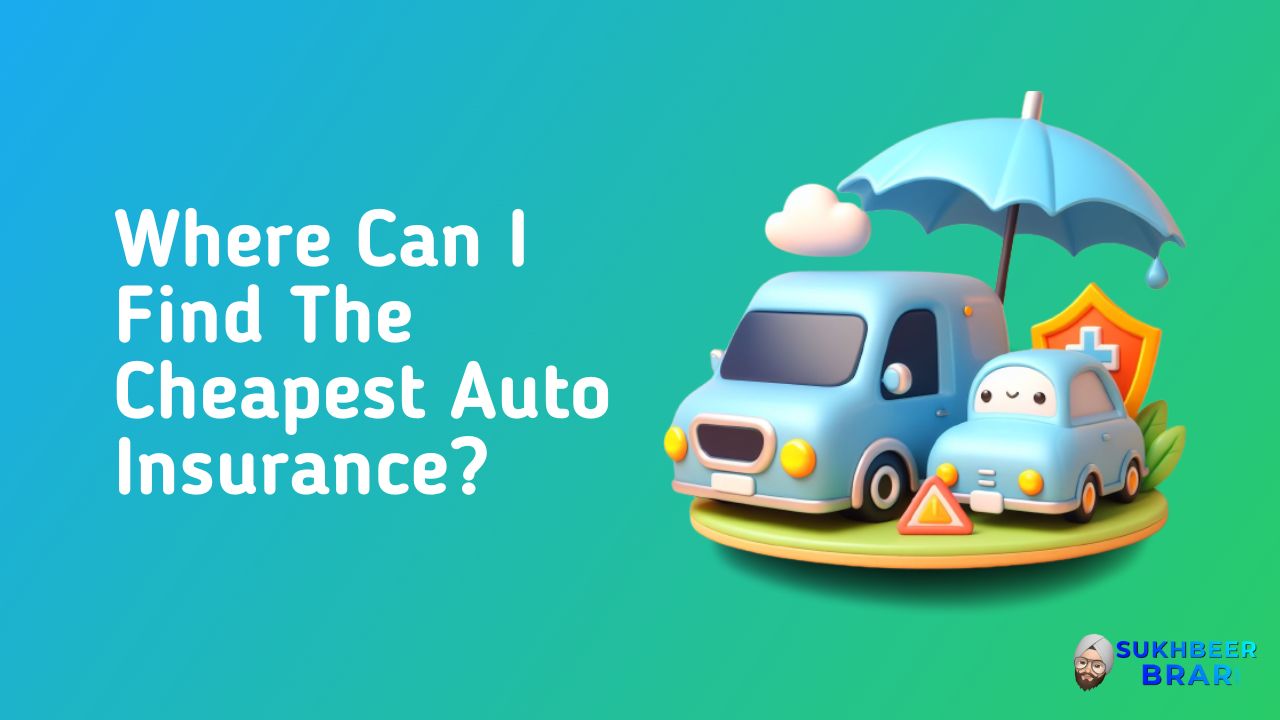Finding the cheapest auto insurance rates can seem daunting, but it doesn’t have to be. Auto insurance prices can vary widely between different insurance companies and policies. While there’s no one company that offers the guaranteed lowest rates for every driver, there are ways to compare options and find the cheapest auto insurance for your situation.
Doing research and getting multiple quotes is key when looking for the most affordable coverage. Rates are based on many factors including your driving record, location, age, gender, type of vehicle, and more. Understanding these pricing variables and taking steps to save can lead to significant savings on your premiums.
This guide will walk through strategies for finding the cheapest car insurance rates and provide tips to lower your costs. Comparing minimum requirements, looking at specific insurance companies, bundling policies, maintaining good credit, taking advantage of discounts, modifying coverage levels, and utilizing online quote tools can all help you get the best rate. With some work, it’s possible to obtain quality auto insurance while also meeting your budget.
Why Auto Insurance Rates Vary
Auto insurance rates can vary widely based on a number of factors related to the driver. Insurance companies take into account things like your age, gender, driving history, credit score, and more when calculating your premiums.
One of the biggest factors is age. Teenage drivers tend to pay the highest premiums since they are considered high-risk drivers due to their lack of experience behind the wheel. But rates start to go down as you get older, with drivers in their 50s and 60s generally paying the lowest premiums.
Gender also plays a role. Statistics show that male drivers tend to get in more accidents than females, especially serious ones. So insurance rates for young male drivers are typically higher than those for young female drivers.
Your personal driving history has a big impact as well. Drivers with clean records and no accidents or tickets pay less than those with moving violations and at-fault accidents. Just one ticket can increase your rates substantially. Multiple tickets or a DUI can make rates skyrocket.
Your credit-based insurance score can also affect what you pay for coverage. Insurers have found a correlation between low credit scores and higher claim rates. So those with poor credit tend to pay more than drivers with good credit.
Compare Minimum State Requirements
Auto insurance requirements vary widely across the United States. Each state sets its own minimum liability coverage that drivers must carry. The three main components of minimum auto insurance are:
- Liability coverage – pays for damage or injuries you cause to others
- Personal injury protection (PIP) – covers medical expenses for you and your passengers
- Uninsured/underinsured motorist – covers costs if you’re hit by a driver with no or too little insurance
State-required minimums range from as low as $10,000 in property damage liability in Arizona to as high as $50,000/$100,000 bodily injury liability in Alaska. In general, states in the northeast and along the west coast tend to have higher minimums. States in the south and midwest tend to have lower requirements.
For example, New York requires drivers to carry at least $25,000 in bodily injury liability per person, $50,000 per accident, and $10,000 in property damage. Florida only requires $10,000 in PIP and $10,000 in property damage (but does require $10,000 in bodily injury per person). Comparing your state’s specifics to others’ can give you an idea of where minimums fall on the spectrum.
Higher minimum requirements mean higher baseline insurance rates in that state, as more coverage is mandated. But having state minimums may leave you underinsured. Experts recommend carrying more than the minimum liability to properly protect your assets.
Look at Premiums by Insurance Company
One of the best ways to find the cheapest auto insurance is to get quotes from multiple highly-rated insurance companies. While every driver’s situation is different, some companies tend to offer lower premiums overall or excel in certain areas like customer service.
Geico, State Farm, and Progressive usually have some of the lowest rates and largest market share in most states. Geico is known for low-cost policies and clever advertising, while State Farm has a reputation for great customer service. Progressive tends to appeal to high-risk drivers with DUIs or accidents on their records.
USAA is another affordable option but only for military members, veterans, and their families. Erie Insurance offers competitive pricing in the Mid-Atlantic region. Certain regional companies like Auto-Owners Insurance or New Jersey Manufacturers Insurance can offer bargains in their local territories too.
After getting quotes, look at industry surveys and online reviews to see customer satisfaction scores. J.D. Power, Consumer Reports, and sites like cleartomer.com rate the top companies on claims handling, pricing, customer service, and overall satisfaction. While price is key, it’s also important to consider a company’s reputation and reliability when buying auto insurance.
Bundle Home and Auto Policies
You can potentially save a significant amount of money on your auto insurance premiums by bundling your auto policy with a homeowners, renters or condo insurance policy from the same provider. Most major insurance carriers offer a multi-policy discount if you insure both your home and auto with them. This bundling discount is typically around 5-15%, which can add up to hundreds of dollars in savings per year.
The reason insurance companies offer this is to incentivize customers to purchase multiple insurance products from them. It benefits the insurance carrier to have more of your business, so they pass some of the savings on to you. Bundling also allows you to more conveniently manage all your policies through one company. You’ll only have to deal with one insurer for all your claims, customer service needs and billing. Just make sure to compare bundled quotes from various providers, as the multi-policy discount may vary. Bundling your home and auto insurance is an easy way to potentially save a good chunk of money every year.
Maintain Good Credit
Your credit score can have a big impact on your auto insurance rates. Insurance companies view drivers with poor credit as more high-risk and more likely to file claims. As a result, having a low credit score can increase your insurance premium significantly.
On the other hand, drivers with excellent credit are seen as lower risk and tend to pay the lowest rates. Insurance companies give discounts ranging from 10% to 50% for good credit scores. This means maintaining a high credit score can directly translate to large savings on your insurance policy.
Some specific ways your credit affects auto premiums:
- Insurance companies pull your credit report when pricing your policy. The higher your credit score, the larger your discount.
- Poor credit can increase your rates substantially, while excellent credit can reduce your costs.
- Improving your credit over time can lead to lower premiums when policy terms renew.
- Significant dings to your credit from new delinquencies or collections may increase your rates at renewal.
- Bankruptcies, tax liens, repossessions, and foreclosures negatively impact your score.
- Late payments, maxed out cards, and hard credit inquiries also lower your credit.
The bottom line is that keeping your credit score high and limiting negative marks can save you money on car insurance. Pay bills on time, reduce debts, dispute any errors on your credit report, and monitor your credit. A clean credit history rewards you with big auto insurance discounts.
Read Also: Do I Need Travel Insurance For Australian Cruises?
Take Advantage of Discounts
One of the best ways to find the cheapest auto insurance is to take advantage of common discounts offered by insurance companies. Here are some of the most common discounts to ask about:
Good Driver Discounts
Most insurance companies offer significant discounts for drivers with clean records free of accidents, traffic violations, or claims. Maintaining a safe driving record for 3-5 years can reduce your premiums by up to 30%.
Low Mileage Discounts
Drivers who limit the annual mileage on their car can also save money on their premiums. If you drive less than the typical 10,000-15,000 miles per year, you may qualify for low mileage discounts.
Defensive Driving Discounts
Completing an approved defensive driving course can earn you a discount on car insurance premiums for up to 3 years. Defensive driving teaches accident avoidance skills and can save you 5-15%.
Other Discounts
Additional discounts may be available for mature drivers, students with good grades, cars with safety features, multi-policy bundles, and more. Be sure to ask your insurance agent about any discounts you may qualify for.
Taking advantage of auto insurance discounts is one of the most effective ways to find cheap car insurance rates. Maintaining a clean driving record, limiting mileage, and taking defensive driving courses are simple ways most drivers can reduce their premiums.
Modify Your Coverage
One way to lower your auto insurance premium is by modifying your coverage. Increasing your deductible or dropping extra coverage like rental reimbursement or roadside assistance can reduce your rates.
Most states require a minimum amount of liability coverage – this covers damage and injuries you cause to others. This minimum is usually quite low, around $25,000. Consider increasing your liability coverage to protect assets like your home or savings in case you are sued.
Comprehensive and collision coverage pay for damage to your own vehicle. You can lower premiums by increasing deductibles for these coverages to $500 or $1000. Just be prepared to pay that amount out of pocket if you file a claim.
Additional coverages like rental reimbursement or roadside assistance are optional. Skipping them can save a bit on your premium. Evaluate whether they are worth the extra cost or if you could cover those expenses yourself if needed.
Modifying your auto insurance coverage gives you some control over the premiums you pay. Just be sure to carefully consider the risks and have adequate protection for assets before dropping key coverages.
Compare Quotes Online
Using auto insurance quote comparison sites is one of the easiest ways to find the cheapest car insurance rates. These sites allow you to get quotes from multiple top insurance providers all in one place.
To use a quote comparison site, you simply enter your basic information like age, vehicle make and model, driver history, etc. The site will then provide real quotes based on that data from various insurance companies. This makes it easy to compare rates side-by-side and see which insurer offers the lowest price.
Some of the best auto insurance quote comparison sites include TheZebra.com, Gabi.com, PolicyGenius.com, and NerdWallet.com. These sites partner with reputable national and regional insurance providers to give you accurate rate estimates.
The main benefit of using quote comparison sites is that you can get multiple quotes without having to contact each insurer individually. This saves a tremendous amount of time and effort. Within just a few minutes, you can see prices from over a dozen top providers in your area.
Overall, getting free quotes from multiple insurers online is the easiest way to find the cheapest car insurance rates. Take advantage of comparison sites to simplify your rate shopping. Just enter your basic info once, and instantly see which company offers the lowest premium.
Conclusion
When looking for the cheapest auto insurance, it’s important to shop around and compare rates across multiple insurers. The cheapest insurer can vary widely based on your location, driving record, age, vehicle, and other factors.
While each insurer uses its own formula to calculate premiums, there are several common strategies you can use to find cheaper rates:
- Compare minimum state requirements – Choose just the minimum liability coverage required in your state if you want the cheapest possible premiums. However, this leaves you vulnerable in the event of an accident.
- Bundle home and auto policies – Insurers will often discount premiums if you purchase both homeowners and auto coverage from them.
- Maintain good credit – Those with excellent credit scores typically enjoy the biggest discounts on auto insurance. Keeping your credit clean can save you substantially.
- Take advantage of discounts – Car insurance companies offer discounts for defensive driving courses, good students, affinity memberships, insuring multiple vehicles/drivers, and more. Inquire about any discounts you may qualify for.
- Modify coverage – Consider dropping collision/comprehensive coverage on older vehicles. Increase deductibles. Drop extras like rental reimbursement or roadside assistance.
- Compare quotes – Getting quotes from multiple providers is key to finding your cheapest rate. Be sure to compare standardized quotes with identical coverage limits and deductibles.
With some time invested upfront in researching and comparing quotes, you can likely save hundreds of dollars a year on auto insurance while still getting good coverage. The cheapest rates are available for the drivers willing to shop around.



